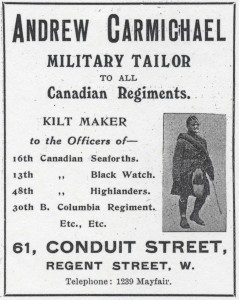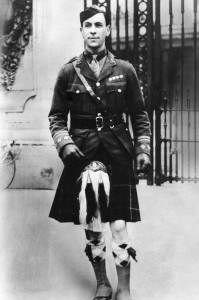Andrew Carmichael Kilt Maker
Military Tailor to All Canadian Regiments Etc., Etc.
It was time (recently) to start drifting through the many pages of research I tracked down by wandering the stacks of the University of Victoria. It’s good to wander the library’s aisles, stopping to take a look at old volumes just to see what they might contain. I recall now looking at some old public school Great War nominal rolls from the United Kingdom complete with fine full-page portrait photographs and a half-page or more of biographical information on the opposite page. Volumes that have sat a long time without having been looked upon for many years – you can tell because they are a bit tight to pull from in between the books on either side that have seemingly been equally cast adrift like their central brethren, albeit in an anchored fashion on the piers of shelving on Third Floor and Third Floor Mezzanine.
I continue to wander looking through the Who’s Who, Victorian and Edwardian pictorials about colonial Africa and such. I move along and eventually return to one of my old familiars, the “Canada Magazine, an Illustrated Weekly Journal” , a resource that I first saw during my first year of University and a volume I have gone through, oh how many times, since 1977!?!? Good gracious. There are rewards in doing such research and it is the grandest thing that sometimes you return to these old sources, start turning the pages and you begin to find new things, things you have not thought of before, or things that well, frankly,…didn’t interest you before. We change over the years with our research abilities. We develop new interests that make us more aware and as I have always done – I look for connections – things to bring together and perhaps things I have not thought of before, or at the time wondered how I might ever use them.
I look at the research page before me and smile to myself. I have no recall of ever having copied the page but as I look at it I can see why it was duly taken to the copy machine and brought home that day. In the upper left corner of the page, there is a fine advertisement for Andrew Carmichael, a military tailor to Canadian Regiments and kilt maker to Canadian Highland Regiments. Included in the ad’s list of Canadian units are the 16th Canadian Seaforths (sic), the 13th Canadian Black Watch, the 48th Canadian Highlanders and the 30th B.C. Regiment. Hmmm, never thought of the 30th as a Scottish Regiment, they were the 2nd B.C. Regiment, but maybe Mr. Carmichael was confused, perhaps Cyrus Wesly Peck, originally of the 30th had a kilt made when he went on to the 16th Canadian Scottish, not the 16th Canadian Seaforths as the Carmichael ad tells us. Still it is not a complaint of the Carmichael record. I am more pleased to have the ad, and especially one that highlights the 16th Battalion!
Can you just imagine Mr. Carmichael’s firm engaged in this task in Great War London? The ad, dated May 13, 1916, tells us his business was located at 61 Conduit Street (Regent Street West), and so I decide to check Google maps to see what is there now. Methinks two double-decker buses mask the address so I will have to go there to see for myself sometime soon. It will be a good visit and one that is sure to lead to a few pictures taken and likely another blog to speak of that morning or afternoon adventure.
Returning to Mr. Carmichael I allow the imagination to once again take over and I can hear the banter and chatter in his store as Scottish officers from Canada, Australia, South Africa, Scotland, England – wherever there may be Scots (as I am sure Mr. Carmichael sold kilts to any Scottish unit from wherever they hailed!) – placed their requests for Scottish apparel.
The accents must have been wonderful and I become curious where Mr. Carmichael himself was from? Then my interest in “wanting to know”, takes over and I wonder if any Carmichael kilts have survived? I am sure there are a few around but I wonder did Mr. Carmichael sew maker labels into his kilts. Is his name there to tell us that an officer had visited 61 Conduit Street during the Great War? Perhaps there is a 16th Battalion C.E.F. kilt out there with a white cotton label affixed, the firm’s name in forest green script with the address in upper and lower case stitched below. Most lucky of all would be the name of the officer it was made for penned in place, stitched in place or perhaps recorded in blackened type. One can just imagine the store, pins and scissors, fabric and measuring tapes, tartan reference books and staff darting about or was it just a quiet shop that made a fine product with soft spoken personable staff nodding their heads as the officers brought their interests forward?
Once again the mind has taken over leading me (us) to far and distant shores. That is the great thing about history, and the passion for it. History takes you to places you never imagined before. Sometimes we harness that imagination and visit the actual place, and in this instance, one ad, one bit of inspiration and sometime soon, a visit to London where 61 Conduit Street will be the catalyst of the day. Will there be buses in the way that day or will I have to stand awhile to see them pass but more importantly…for me…to see and at least stand near the good Mr. Carmichael’s shop, kilt maker to Canadian officers…Etc. Etc.
Did you know?
James McIvor of the 16th Battalion C.E.F. (Canadian Scottish) was awarded both the Military Cross and Military Medal during the Great War.
Citation for the award of the Military Medal (Announced London Gazette 9 December 1916)
“During the period Sept; 3 – 7th, the conduct of this N.C.O. was a splendid example to all those about him. He bore himself with a calm stolid courage and contributed in no small way to our success in holding the trenches. He has been sixteen months at the front and has always been noted for his faithful and gallant conduct.”
Citation for the award of the Military Cross (Announced in the London Gazette 16 September 1918)
“For conspicuous gallantry and devotion to duty in a raid on an enemy post. He showed patience and courage in organizing and leading his party. He clambered over the wire, and succeeded in driving in the post, and capturing three prisoners. Although wounded, he personally superintended the withdrawal, and was the last to leave the trench.“



Comments